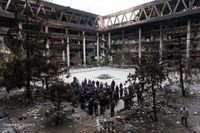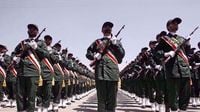On September 22, 2025, the streets of Tehran filled with the thunder of military parades and the somber echoes of remembrance as Iran marked the 45th anniversary of the Iran-Iraq war. Known locally as Sacred Defense Week, this annual commemoration is far more than a ritual—it’s a powerful reminder of a conflict that shaped the nation, claimed up to a million lives, and continues to color Iran’s relationship with the world. But this year’s ceremonies unfolded under an especially charged atmosphere, coming just months after a violent 12-day confrontation with Israel and the United States, and as Iran faces renewed nuclear tensions on the global stage.
The Iranian Revolutionary Guard Corps (IRGC) set the tone with a stern warning directed at the United States and Israel. According to BORNA, the IRGC declared, “In the event of any new miscalculation or aggression by the enemy, the Islamic Republic of Iran will take the initiative on the battlefield with a commanding position and deliver another deadly response.” The statement, issued on Sunday, underscored the heightened sense of vigilance in Iran, as the nation reflected on both the traumas of the past and the uncertainties of the present.
The Iran-Iraq war, which erupted on September 22, 1980, when Saddam Hussein’s Iraq invaded Iran, was a brutal, eight-year ordeal. Driven by disputes over the Shatt al-Arab waterway and Hussein’s desire to weaken Iran after the 1979 Islamic Revolution, the conflict saw massive battles, missile strikes, and chemical weapons attacks. It ended with a ceasefire, but neither side gained significant territory. As reported by the Commerce Department and other outlets, Iran continues to keep the memory of this war vivid, while Iraq, since the fall of Saddam Hussein in 2003, no longer holds official commemorations.
This year’s Sacred Defense Week comes at a time when Iran is embroiled in another confrontation—this time over its nuclear program. Western powers, led by Germany, France, and the United Kingdom, are pushing for the reimposition of sanctions on Tehran, citing concerns over nuclear activities. President Masoud Pezeshkian, speaking on September 21, was defiant: he insisted that Iran would overcome any reimposition of sanctions through the so-called ‘snapback’ process, after the UN Security Council opted not to permanently lift sanctions on Iran. “We will overcome any reimposition of sanctions,” Pezeshkian said, echoing a sentiment of resilience that has become a hallmark of Iranian official rhetoric.
Meanwhile, Iranian Foreign Minister Abbas Araghchi was scheduled to arrive in New York on September 22 to participate in the United Nations General Assembly. This year’s gathering carries extra weight for Iran, as it coincides with a looming September 28 deadline for a possible return of nuclear sanctions. Araghchi is expected to meet with counterparts and oversee preparations for President Pezeshkian’s own visit to UN headquarters, where Iran’s nuclear ambitions and its recent military confrontations will no doubt be hot topics of discussion.
The IRGC’s anniversary statement did not just look backward. It drew a direct line from the lessons of the Iran-Iraq war to the country’s present-day military doctrine. “The enemies’ defeat in the two imposed wars..., and their failure in security, political, economic, psychological, and media battles aimed at creating chaos and destabilizing the country, showed that the Iranian nation, through vigilance, insight, and sacred unity, stood like a steel fortress against the enemies’ hybrid warfare and foiled their plots,” the IRGC proclaimed. The message was clear: Iran sees itself as under constant threat, but also as exceptionally prepared to respond.
The sense of readiness is not just rhetorical. The IRGC highlighted ongoing efforts to enhance Iran’s combat capabilities, offensive and defensive power, and strategic capacities. “Effective deterrence stems from constant readiness, strategic and tactical innovation, operational planning in battles, as well as the continuous advancement of defensive and military technologies and systems,” the statement read. This emphasis on innovation and modernization is, in the eyes of Iranian leaders, a direct legacy of the hard lessons learned during the eight-year war with Iraq and the more recent 12-day war with Israel.
That recent conflict, which erupted on June 13, 2025, and lasted until June 24, brought the specter of war uncomfortably close for many Iranians. According to Tehran Times, Israel launched unprovoked strikes against Iranian military and nuclear sites, killing at least 1,064 people—including military commanders, nuclear scientists, and civilians. The United States, for its part, bombed three Iranian nuclear sites, actions Iran condemned as grave violations of international law. In response, Iran launched hundreds of ballistic missiles and suicide drones targeting military, energy, and government sites in Israel and struck the al-Udeid air base in Qatar, the largest American military base in West Asia. By June 24, Iran’s retaliatory operations had, in their view, effectively halted the assault.
The trauma and pride of this recent confrontation are being woven into Iran’s national narrative. On September 22, 2025, Iran approved the establishment of a new museum dedicated to the 12-day war with Israel. Cultural Heritage, Tourism and Handicrafts Minister Seyyed Reza Salehi-Amiri announced that exhibits from the recent conflict would be displayed alongside those from the 1980–1988 Iran-Iraq war at the Sacred Defense and Islamic Revolution Museum. Salehi-Amiri described the Iran-Iraq war as a defining factor for the 1979 Iranian Revolution and national independence, and emphasized that the “spirit of resistance and sacrifice” shown during the 12-day war should not be forgotten.
“Unlike the image portrayed abroad, those wars have been a source of cohesion in the Iranian society,” Salehi-Amiri stated, highlighting the role of war veterans and commanders as symbols of national dignity. The government also announced plans for 31 cultural festivals across Iran’s provinces to promote heritage and strengthen national identity among younger generations. The message is unmistakable: both the Iran-Iraq War and the 12-day conflict with Israel are not just chapters of suffering, but pillars of unity and resilience.
As the UN General Assembly convenes and the world’s eyes turn to New York, Iran’s leaders are keen to project both strength and a willingness to engage diplomatically. Yet the specter of renewed sanctions, the memory of recent violence, and the enduring scars of the Iran-Iraq war all weigh heavily on the nation’s psyche. The annual parades and memorials are not just about the past—they are a statement about Iran’s determination to face whatever comes next, with the lessons of history firmly in mind.


